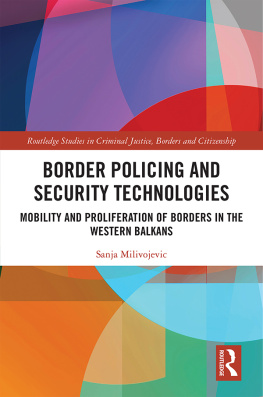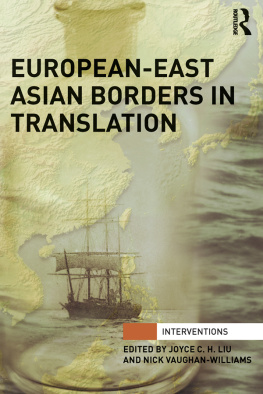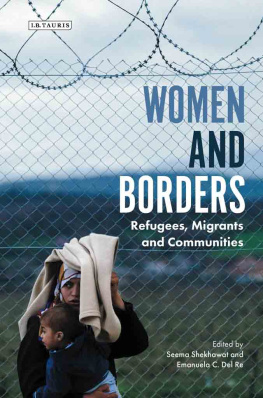Bordering and Ordering the Twenty-first Century
Human Geography in the New Millennium
Issues and Applications
Series Editor
Barney Warf, Florida State University
Human geography is increasingly focused on real-world problems. Applying geographic concepts to current global concerns, this series focuses on the urgent issues confronting us as we move into the new century. Designed for university-level geography and related multidisciplinary courses such as area studies, global issues, and development, these textbooks are richly illustrated and include suggestions for linking to related Internet resources. The series aims to help students to better understand, integrate, and apply common themes and linkages in the social and physical sciences and in the humanities, and, by doing so, to become more effective problem solvers in the challenging world they will face.
Titles in the Series
Boundaries of Faith: Geographical Perspectives on Religious Fundamentalism
Roger W. Stump
Six Billion Plus: Population Issues in the Twenty-first Century
K. Bruce Newbold
Popular Culture, Geopolitics, and Identity
Jason Dittmer
Bordering and Ordering the Twenty-first Century: Understanding Borders
Gabriel Popescu
Bordering and Ordering the Twenty-first Century
Understanding Borders
Gabriel Popescu
Rowman & Littlefield Publishers, Inc.
Lanham Boulder New York Toronto Plymouth, UK
Published by Rowman & Littlefield Publishers, Inc.
A wholly owned subsidiary of The Rowman & Littlefield Publishing Group, Inc.
4501 Forbes Boulevard, Suite 200, Lanham, Maryland 20706
http://www.rowmanlittlefield.com
Estover Road, Plymouth PL6 7PY, United Kingdom
Copyright 2012 by Rowman & Littlefield Publishers, Inc.
All rights reserved . No part of this book may be reproduced in any form or by any electronic or mechanical means, including information storage and retrieval systems, without written permission from the publisher, except by a reviewer who may quote passages in a review.
British Library Cataloguing in Publication Information Available
Library of Congress Cataloging-in-Publication Data
Popescu, Gabriel, 1971
Bordering and ordering the twenty-first century : understanding borders / Gabriel Popescu.
p. cm. (Human geography in the new millennium : issues and applications)
Includes bibliographical references and index.
ISBN 978-0-7425-5621-8 (cloth : alk. paper) ISBN 978-0-7425-5622-5 (pbk. : alk. paper) ISBN 978-1-4422-1325-8 (electronic)
1. Borderlands. 2. Boundaries. 3. Human geography. 4. Political geography. I. Title.
JC323.P67 2012
320.1'2dc23
2011022753
 The paper used in this publication meets the minimum requirements of American National Standard for Information SciencesPermanence of Paper for Printed Library Materials, ANSI/NISO Z39.48-1992.
The paper used in this publication meets the minimum requirements of American National Standard for Information SciencesPermanence of Paper for Printed Library Materials, ANSI/NISO Z39.48-1992.
Printed in the United States of America
To Jodi and Derek
Preface and Acknowledgments
During the summer of 1989, I was attending summer camp in northern Romania near its border with the late USSR. One day, while on a field trip, we reached the location of the state border. It was a narrow, shallow river, and on the other side we could see a road, a couple of houses, and a few cars passing by. Eastern Europe was under communist rule at that time. Romania endured oppressive rule under the dictatorship of Nicolae Ceausescu. Few people had passports, and traveling abroad, while not technically illegal, was strongly discouraged and was seen as suspicious by an increasingly paranoid regime that governed its people through fear. Romania was a prison at the time, and its borders were the walls.
The border scene appeared surreal to me, a high school student at the time. The scenery was inviting. There was no sign of the physical disruption that is usually associated with border landscapes. There were no border fences or watchtowers anywhere in sight, just a sunny, forested landscape, with a gurgling creek and a winding road. I felt a strong urge to cross to the other side of the river to a forbidden, unknown place. Then it crossed my mind that this would mean escaping to freedom. For years, I had listened to clandestine radio broadcasts from Western Europe extolling the virtues of capitalism and democracy, and how these countries were welcoming defectors from the communist camp with open arms. However, I could not bring myself to cross the river. Truth be told, there was no point in escaping to the USSRthere was communism there too. I would have been handed back to the Romanian authorities. But this is not the point of the story. I could not cross because I knew it was a border, and crossing it might have had unwanted consequences for the rest of my life. There was no barrier in the middle of the water. The border was all in my mind.
By the end of that year, both Ceausescu and communism were history in Romania. The walls of the prison tumbled down overnight. There I was, free to roam the globe at last. I quickly used my newly gained political freedom to get a passport and started to travel, taking my revenge on borders, so to speak. In a short time, I traveled in Europe from Turkey and the former Yugoslavia in the south to Poland in the north. However, when I wanted to head farther west into Europe, I found with surprise that it was not that easy for me to gain entry to the West. I first needed a visa, which was difficult to obtain because its requirements largely disqualified someone like me, an undergraduate student interested in backpacking, not in traveling with an organized tour with a predetermined itinerary and expensive hotel. Suddenly I found myself on the wrong side of the border again, with a geographical twist though; this time I was trying to cross in, not to cross out.
This is how I found out that, for me, the borders of France and Germany were not where I knew them to be, but in and around well-guarded embassy buildings in downtown Bucharest. I also learned that these borders were not so formidable after all. Around these buildings, I was approached to pay hefty prices for Western visas if I really wanted so badly to travel there. That is, I could have crossed these telescopic borders if I were willing to bribe the embassy employees in these buildings. This made little sense to me. Why would I pay thousands of dollars for a visa when I was going there to spend my own meager student money? What did make sense, though, was that whoever was willing to pay a bribe worth thousands of dollars to get a visa would not go to France or Germany for tourism. They would go there to stay and send money back any way they could. And so it has become clear to me what a poor fix borders make for systemic issues whose origins lie elsewhere in the world system.
Much has changed since the early 1990s. I eventually traveled extensively in Western Europe and then moved across the ocean to the United States, from where I continued to cross borders regularly, both in my private and professional life. The citizens of my new country enjoy the luxury of crossing most borders visa free. My birth country has joined the European Union, and its citizens can now easily travel throughout much of the world as well. My border story is by no means either unique or the most powerful. There are millions of other stories out there that can teach us much about borders. However, this story reminds me that much has not changed in the world for millions of others. The borders that once excluded me are now to be found elsewhere, in the streets of Moscow, Mexico City, Lagos, and Beijing, to name a few.
I wrote this book with the many others in mind, those who cannot take border crossing for granted because of the geographical assignment the lottery of their birth has dealt them. I also thought of those who have this right but are in danger of losing it in the future because they do not understand it well enough to fight for it.









 The paper used in this publication meets the minimum requirements of American National Standard for Information SciencesPermanence of Paper for Printed Library Materials, ANSI/NISO Z39.48-1992.
The paper used in this publication meets the minimum requirements of American National Standard for Information SciencesPermanence of Paper for Printed Library Materials, ANSI/NISO Z39.48-1992.